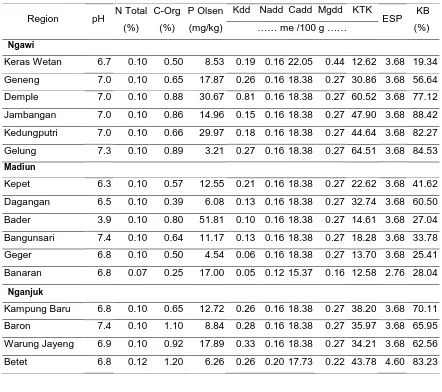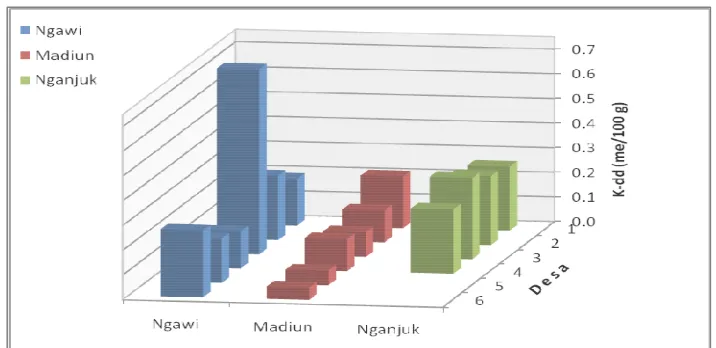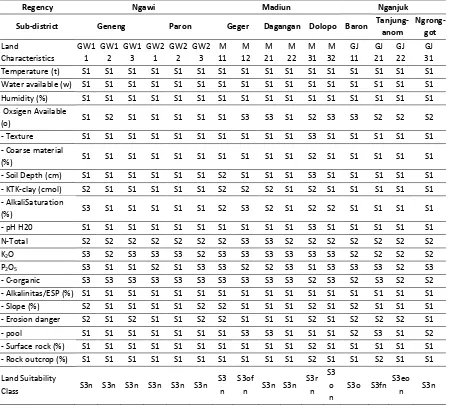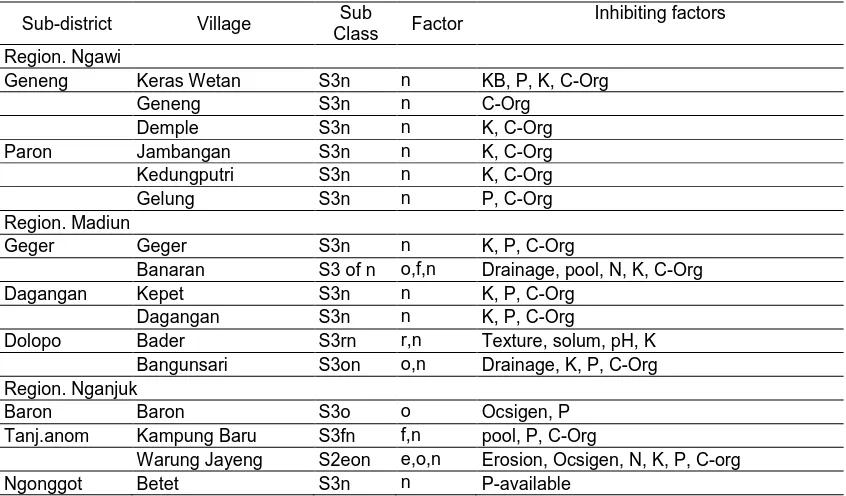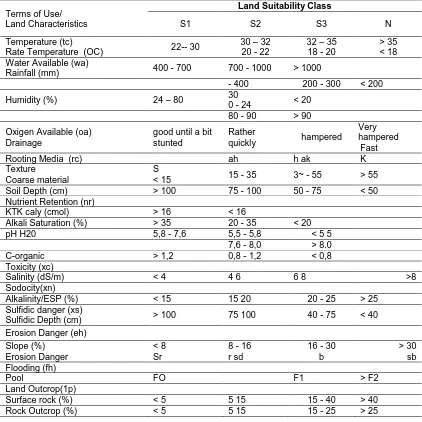LAND CHARACTERISTICS TO INCREASE SUGAR CONTENT OF
MELON FRUIT (Cucumis melo)
Bakti Wisnu W, Purwadiand Siswanto
Faculty of Agriculture -UPN “Veteran” East Java, Surabaya, Indonesia
ABSTRACT
Sugar content is primary importance in determining the quality of melon fruit. Quality melon Nganjuk region, Madiun and Ngawi when glucose levels decreased to below ten (10) Brix, so that does not taste sweet and not durable to be stored. Departing from low sugar levels, which pushed to find reasons for the decrease in sugar content of fruit in terms of land characteristics and environmental characteristics. The purpose of this study is to examine the characteristics of land to do with the chemical characteristics of fruit, especially melons melon fruit sugar content. Materials are. (1) The soil layer 0-20 cm of the soil surface. Soil samples from the center area are Nganjuk melons, Madiun and Ngawi. Each regional center of the melon is represented by six (6) observation point on land characteristics. Observations on land characteristics include. Climate data from the station or the nearest local climatology, physical characteristics, chemical and biological soil, and soil geomorphology. Climate data and geomorphological data useful for determining the level of land suitability for crop melons, while data on land characteristics useful for identification of land quality and soil fertility degree to which the modeling of the relationship with the Chemical characteristics of melonfruit. The results of this study indicate that nearly all regions Region. Ngawi, Madiun and Nganjuk there is a limiting factor content of C-Organic and low potassium. There is a relationship between sugar levels content and land characteristics, especially with potassium content.
Key words: land characteristics, sugar content, melon
INTRODUCTION
Now we know the characteristic of environmental and land affects the chemical characteristics fruit can be manipulated to increase the quality of the fruit so it looks, sugar and fruit can be improved durability. Melons that are demanded by the Indonesian society are largely determined by the appearance and quality of flavors they contain. Business melon cultivation in Nganjuk, Madiun and Ngawi region, when glucose levels decreased to below ten (10) brix, so it is not sweet and not durable to be stored. Departing from low sugar levels which encourage the desire of researchers to find out reasons for the decline in sugar content of fruit in terms of land characteristics and properties of the environment.
The purpose of this study is to examine the influence of climatic and geomorphological characteristics, physical, chemical and biological characteristics of melon fruit chemistry, particularly the sugar content of melon fruit.
MATERIALS AND METHOD
The study was conducted from May 2007 to August 2007 conducted in three central areas in East Java melon i.e Nganjuk, Madiun and Ngawi. The research method used is a survey, identification, evaluation, and correlations between factors and quality characteristics of the land with the production and quality of melons. Analysis of soil properties and content of melon performed at the Laboratory of Soil Science Department Faculty of Agriculture, UPN "Veteran" East Java, Surabaya.
The survey was conducted for the determination of the point representing the sampling of Nganjuk area, Madison and Ngawi, followed by secondary data collection. Sampling was randomly performed on each of the six sample point locations Climate data (CH, evaporation, humidity, wind speed and temperature) taken from the nearest climatic station. Visual observation and retrieval of soil sampling conducted at six (6) sample point of the survey area to determine the characteristics of the land. Identification of geomorphological characteristics, physical and biological fieldwork, including soil color, condition of the surface rocks, erosion, drainage, rooting, consistency, solum thickness and effective rooting depth by making the soil profile.
is used to determine the saturated conductivity, bulk density, particle density, and porosity. Soil samples used for analysis of soil texture pipette method to see the percentage of soil fraction of the size of the laboratory scale. Analysis of the N microkjeldahl-total method, analysis of soil with a pH-extraction ratio of 1.2 soil paste as measured by pH meter, P-available by the method of Bray-1 or Olsen depending on soil pH values, CEC and Cadd, Mgdd, KDD extracted with NH4OAc 1 N at pH 7.0 and measured with flamefotometer for K and EDTA to Ca and Mg. Total Organic Carbon (TOC) measured by the Walkey and Black method. The sugar levels were measured with refragtometer.
Geomorphological characteristics of the physical, biological and chemical soil from three sampling locations and their classify climatic data, is used to determine the quality of land used as a basis for evaluating land suitability and soil fertility. Level parameters and fertility of soil suitability analysis is done by correlating between: a). Land suitability classes with quality of fruit, and b). Soil fertility class with quality of fruit.
RESULTS AND DISCUSSION
Land characteristics
Soil Physical properties
Observation of physical properties and morphological parameters of soil was conducted in field and laboratory. Parameters morphological properties include slope class, rock surface, rock outcrops, drainage conditions, effective soil depth. While the observations made in the laboratory is the observation of soil texture. In addition to the physical properties of soil, to assessment of land suitability classification system to be supported analysis of soil chemical properties. Parameters of the chemical properties of soil is soil acidity (pH), available K, total N, available P, Ca, Mg and CEC.
Slope factor taken into consideration in land suitability classification system is the ease concerning aspects of land management and land conservation aspect. Modern agriculture one character is implementation of agricultural mechanization technologies in the production business. But the mechanization of agriculture will have difficulty applied on sloping land. Similarly, from the aspect of sustainability of land, on land that has a certain slope, erosion hazard is an important consideration. The greater the slope the greater the erosion hazard. Described Utomo (1990) that the slope of the land affects the speed and volume of surface runoff. Where an increasingly steep slope, the faster the rate of surface runoff and thus shorten the time for infiltration of surface runoff water volume is also greater. So with the growing magnitude of the slope the greater the erosion.
Container throughout the study area ranges from 60 cm to 90 cm. Lands in the village Kedungputri, Gelungan (Region. Ngawi), Bangunsari, Banaran (Region. Madiun), Baron, Kampungbaru, Warujayeng, and Betet (Region. Nganjuk) has a deep container (> 90 cm). While in the village Keraswetan, Geneng, (Ngawi), Kepet, Dagangan, Bader, and Geger (Madiun) has a rather deep cup (60-90 cm).
Container land is a place or medium in which plant roots are able to penetrate through the rock mass is limited by a hard and compact. Thus, the deeper the container land, then plant roots will grow better if other growing factor in a state of Optimum. In consideration of the development of roots, container land with a depth> 90 cm are suitable for melon plants (Wahyuningrum, et al. 2003).
Results of analysis of soil texture (Table 2) shows that the texture of the soil depth of 00-20 cm is loam, silty loam and sandy caly loam. Keraswetan village, Geger and Banaran textured loam, and in Geneng ,Dempel, Jambangan, Gelung, Kepet, Merchandise, Bangunsari, Baron, Kampungbaru, Warujayeng and Betet village silty loam-textured soil. While in the village Bader silty clay loam-textured soil.
texture dusty is the best class. This fact is due to melon crops have low tolerance for high clay content. Besides, melon plants need loose soil and good pore distribution, where the ratio of water and air in the soil balanced (Vink, 1975 in Suharto, 1980).
Soil Chemical Properties
Classification of land suitability assessment in order to plant melons conducted soil sampling for analysis of chemical properties of soil. Parameters of soil chemical properties were observed for assessment of land suitability classification in this study is the soil acidity (pH), the C-org, available P, K-dd, Na-dd, dd-Ca, Mg-Na-dd, Tukat Cation Capacity (CEC), Excangeable Persentage Sodium (ESP), and base saturation. Results of analysis of the chemical properties of soil parameters studied area are presented in Table 3.
Table 3. Results Analysis of Soil Chemical Properties Areas of research
Soil acidity, or more commonly called the pH of the soil, the condition affects other soil properties. Nature of the soil can be affected soil pH among the other nutrient availability and CEC. In addition the pH of the soil also affects the activity of microorganisms in the soil. Bacteria and aktinomycetes thrive in moderate to high soil pH. Their activity is reduced at a pH of less 5.5. While the dominant fungi at low pH (Judge et al., 1986). Soil acidity throughout the study area at depths of 0-20 cm showed uniformity ranged from slightly acidic to slightly alkaline (6.3 s / d 7.4), except in the village Bader (Madiun) reacts very acidic (3.9). It is possible that soil samples taken previously dilahan fields for cultivation of paddy rice cultivated continuously. Soil acidity which ranged from slightly acidic to slightly alkaline enables the availability of nutrients in optimum condition for growing melons.
Figure 1 below shows the differences in soil pH at the sample points where the research in three districts. From the pictures can be seen that the pH of the soil study area average of 6.7 variation of 0.65. Variations in soil pH value this small indicates that the capacity of the soil supporting good enough. Soil pH changes not only sustain but also supports the nutrients in the soil at the time of excessive tissue and in low released into soil solution (Tan, 1982).
Demand for a soil pH is not the same for plant species at several levels of acidity.. This situation is presumably because tolerance of crops to the concentration of H + ions and other toxic ions different too. Effect of pH can be tolerated when the
Figure 2. Soil KTK Value in points of observation locations
nutrients in optimal balance. Similarly melon plants, for optimal growth requires a soil pH conditions between sour to slightly acidic (5.0 6.0) (Deptrans, 1984 in Sitorus. 1989). Thus, soil pH conditions in the area of study tend to be higher than the optimum conditions for growing melons, although not too extreme. CEC indicates the amount of cations that can be exchanged in the soil, both mineral soils and organic soils. CEC existence can be affected by soil pH and soil texture. In the organic colloids, with increasing soil pH, CEC showed an increase too and the more finely ground texture, the higher the CEC.
Based on the results of laboratory analysis and graph drawing 2 above, the CEC sample points lower in research areas including villages Keraswetan, Bader, Geger and Banaran (12.62, 14.61, 13.70, 12.58 me/100 g), was at the village Geneng, Kedungputri, Bangunsari, Kampungbaru, Baron, Warungjayeng and Betet (between 18.28 s / d 44.64 me/100 g), high in the village Jambangan (47.90 me/100 g), and very high in the village Dempel and Gelung (60.52 and 64.51 g me/100 ). Judging from the growing requirements of melon plants in the CEC research areas, good condition (Deptrans, 1984 in Sitorus, 1989).
The content of N-total research areas include low category with a range of 0.07% in the lowest and highest village Banaran 0.12% village Betet. Graph Figure 3 shows that the total soil N-content of the entire study area is relatively equal, with an average of 0.10% with a variation of 0.0001%. Based on the melon plants growing conditions, the dose of N-total is less than 0.10% is very suitable for melon plants. The content of N-total study area is generally sufficient for melon plants.
C-organic content of the soil belongs to the class is very low in the village of Dagangan and Banaran (0.39% and 0.25%), low in the village Keraswetan, Geneng, Kedungputri, Kepet, Bader, Bangunari and Geger (0.50% - 0.80%), while in villages Dempel, Jambangan, Gelung, Baron, Warujayeng and Betet (0.86% - 1.20%). Organic-C levels reflect the amount of organic materials and microbes that exist in the soil results from the return of the remains of crops after harvest. Although the percentage of organic matter in soil small when compared with other building blocks of soil, but its existence is very important and can not be ignored. Organic matter in oil serves as a buffer all the activities in the soil (Sulistijorini, 2006 and Supardi, 1983).
area once return the remains of plants and other organic material into the soil after harvest (Sulistijorini, 2006). The reality of the field interviews with farmers, farmers in three regions melons do not use organic ingredients as the basal fertilizer with organic material reason as a source of pests and diseases.
Graph Figure 4 below shows that the distribution of soil organic C in the Nganjuk average (0.97%) higher than the average C-organic in the Madiun area (0.53%) and Ngawi (0.74%). While variations of organic-C values for the entire study area by 0.064.
Figure 4. Soil organic C-values in the Observation Locations points
Based on the results of laboratory analysis, available K content of the entire study area varied from very low to moderate. Dose was found in the region near to the village and Warujayeng (0.31 and 0.33 me/100 g), low rural region Geneng, Gelung, Kampungbaru, Baron and Betet (0.26 to 0.28 me/100 g). Meanwhile, in other village areas included in the category of very low doses (0.05 to 0.21 me/100
g). The graph in Figure 5 above shows that the average area Nganjuk exchangeable potassium (0.28 me/100 g) higher than the average of potassium may be exchanged at the Madiun (0.11 me/100 g) and Ngawi (0.23 me/100 g), with variations in the distribution of potassium can be exchanged for the whole area of research areas for 0008 me/100 g.
Judging from the melon crop needs, then the content element of K throughout the village area is a low-dose studies. From this fact shows that the K nutrient uptake by plants melons tranlokasi least once so that the process sugars from the leaves throughout the plant body and into the storage section is inhibited. This indicates low levels of sugar melons.
Based on the results of laboratory analysis, Ca and Mg content available throughout the diverse research areas and nearly reversed from a high to very high (Ca) and very low to low (Mg). Very high dose region of the village there Keraswetan (22.05 to Ca2 + / 100 g) and high in the region other villages (15.37 to 18.33 to Ca2 + / 100 g). As for the low dose region magnesim Keraswetan village (0.44 to Mg2 + / 100 g), very low in the other villages (0.16 to 0.27 to Mg2 + / 100 g).
Graph Figure 6 above shows that the average potassium and magnesium can be exchanged for the Ngawi (18.99 to Ca2 + / 100g, and 0.30 to Mg2 + / 100g) were higher compared the average potassium and magnesium can be exchanged in the area of Madiun (17.88 to Ca2 + / 100g and 0.25 to Mg2 + / 100g) and Nganjuk (18.22 to Ca2 + / 100g, and 0.26 to Mg2 + / 100g), with variations in the distribution
of potassium and magnesium can be exchanged for the entire study area for 1530 to Ca2 + / 100g and 0003 to Mg2 + / 100g.
Judging from the melon crop needs, then the element content of Ca and Mg throughout the village area of research is high and very low dose. Both secondary nutrient elements can be seen each antagonist where a high amount of Ca in soil solution will suppress (inhibitors) the amount of availability Mg (Tan, 1982). The low availability of Mg soil will affect the uptake of Mg is needed as the core crop plant chlorophyll. Nutrient deficiencies in plants melons will result in low yields of sugar photosynthesis. Variations in conditions of physical and chemical properties of soil research in the area suspected as a factor causing variations in the level of sugar content of melon fruit.
Assessment of Land Suitability Class Melon Plants Around the Region Research Unit
Based on field observations regarding the morphology, texture and chemical analysis results of soil assessment of land suitability classes. Valuation of land is intended to determine the level of land suitability for crop melons. As described in the methods of research, this assessment process refer to the guidelines of grouping land into land suitability classes for melon crops (Puslittanak, 1993).
The process of assessment of land suitability classification in this study, ignoring the temperature factor (t) and agro-climate zones (c). It is assumed both factors are uniform conditions throughout the region sauan. Assessment of land suitability classes are classified to the sub-class of land suitability. The results of the classification of land suitability assessment of all territorial units in the study area are presented in Table 4 below. The results of the classification of land suitability Figure 6. Calcium and Magnesium Land values in the Observation
assessment system on the entire unit area of land suitability classes obtained S3 (marginally suitable). S3 land suitability classes with a variety of limiting factors for each of the different territorial units.
Land quality factor is emerging as a land suitability class S3 limiting factor is the availability of oxygen, nutrient retention, rooting media, the danger of flooding and land erosion. Factors limiting the availability of oxygen (o) due to poor soil drainage to limit the use of land to plant melons in Madiun district satual (Banaran villages) and districts Nganjuk (village kampungbaru). Nutrient retention (n) becomes a limiting factor disatuan Ngawi region (seluru village which is used as the sampling), Madiun (the entire village used as sampling), and Nganjuk (Kampungbaru village, Warujayeng, and Betet).
Rooting medium factor (r) becomes the limiting growth in the region melon madiun at village Bader. Flooding or inundation (f) would limit the growth of melon cultivation in the region and the madiun at village Banaran Nganjuk in rural areas Kampungbaru. While the soil erosion factors (e) a constraint on land use in rural areas Nganjuk Warujayeng. The entire unit area of research found seven sub-classes of land suitability. In detail the constraints of land are emerging as a land suitability class boundaries around the unit area are presented in Table 5.
Land Suitability Classification relations with Melon Fruit Sugar Content Levels
Based on the research report Anonymous (2002) found that the sugar content of fruit categorized into a 4 (four) of categories of low (<8%), category of moderate (8-13%) were high (13-18%) and very high category (> 18%).
Measurement of melon sugar content in Ngawi showed that the lowest levels were in the Gelung village i.e 5.4% and the highest were in the Geneng village i.e 7.0%, with an average of 6.25%.
Table 4. Land Characteristics maching with the Terms of Use of Land Melon
Regency Ngawi Madiun Nganjuk
Sub-district Geneng Paron Geger Dagangan Dolopo Baron
Table 5. Sub-Class Land Suitability and Land Use Melon Obstacles in Area
The results of assessment of land suitability classes in a unit area of research all the S3 with the limiting factor is the bulk of land use and nutrient retention in a particular area is limited by oxygen, puddles, roots and erosion. Retention of nutrients into account the CEC determines land use, family planning, total N, available K, pH, available P and C-organic.
Relationship between land characteristics and Melon fruit sugar conten
The relationship between land suitability classes with melon fruit sugar content shown in Figure 7 above. The figure shows that there are close links between the classes of land suitability quadratically with sugar melon. In the Units area Ngawi (S3n class) indicates the tendency of melon fruit sugar levels decreased although not significantly (R2 = 0.316) with the increasing content of K, Ca and Mg soil, whereas in the Madiun area unit indicate a trend of increased sugar content of fruit although it is also not significant (R2 = 0.467). While in the unit area increased content Nganjuk K, Ca and Mg significantly increased the sugar content of melon fruit (R2 = 0.821).
and Ca with melon fruit sugar content (r = -0.644 for K and r = -0.455 for Ca ), while the soil Mg levels showed no significant effect.
Table 6. Melon Fruit Sugar Contens
Sub-district Village Sub
Class Factor
Inhibiting factors Sugar Fruit (%) Region. Ngawi
Geneng Keras Wetan S3n n KB, P, K, C-Org 6.4 (R)
Geneng S3n n C-Org 7.0 (R)
Demple S3n n K, C-Org 5.6 (R)
Paron Jambangan S3n n K, C-Org 6.7 (R)
Kedungputri S3n n K, C-Org 6.4 (R)
Gelung S3n n P, C-Org 5.4 (R)
Region. Madiun
Geger Geger S3n n K, P, C-Org 7.4 (R)
Banaran S3ofn o,f,n Drainage, pool, N, K, C-Org 7.8 (R)
Dagangan Kepet S3n n K, P, C-Org 7.7 (R)
Dagangan S3n n K, P, C-Org 9.3 (S)
Dolopo Bader S3rn r,n Texture, solum, pH, K 7.3 (R)
Bangunsari S3on o,n Drainage, K, P, C-Org 8.3 (S)
Region. Nganjuk
Baron Baron S3o o Ocsigen, P 6.8 (R)
Tanj.anom Kampung Baru S3fn f,n pool, P, C-Org 6.3 (R)
Warung Jayeng S2eon e,o,n Erosion, Ocsigen, N, K, P,
C-org 6.1 (R)
Ngonggot Betet S3n n P-available 6.2 (R)
Tabel 7. Appendix. Terms of Use of Land for Melon (Cucumis melo,L)
The results of this study indicate that nearly all regions Region. Ngawi, Madiun and Nganjuk there is a limiting factor content of C-Organic and low potassium. There is a relationship between blood sugar levels with land characteristics, especially with potassium content
REFERENCES
Anonymous. 2002. Pembajaan. PT. Agro Trading, Botong Three, the New Supplement, Butong 30 100. Ipoh, Perak. Malaysia.
Joko Mursito, 2000. Genetic studies of Agronomy and cropping F2 Some Melon Varieties Hybrids. in Agrosains Vol. 2 No. 1. Faculty of Agriculture UNS, Surakarta.
Long R.L. K.B. Walsh, G. Rogers and D.J. Midmore, 2004. Source-Sink Manipulation to Increase Melon (Curcumis melo, L.) fruits Biomass and Soluble Sugar Content. Australian Journal of Agricultural Research 55 (12). 1241-1251
Moch. Munir, 1996. Indonesia Main Lands. Pustaka Jaya. Jakarta.
Mulyono, 2003. Department of Food Crops and Plantation of Nganjuk District.
Purwadi, 2002. Land Suitability Evaluation Melon Plants in Kediri regency. Mapeta Vol. V. No. 15. pp. 113-117.
Puslittanak, 1993. Land Suitability Criteria For Agricultural Commodities. Agency for Agricultural Research and Development.
Tan K.H. 1982. Principles of Soil Chemistry. Marcel Dekker Inc. New York.
Tjahjadi N. 1989. Melon farming. Canisius Publisher
Tranggono and Sutardi, 1990. Biochemistry and Post-Harvest Technology. PAU.UGM.280p
Sitorus, S.R.P., 1989. Soil Survey and Land Use. Laboratory of Land Resources Development Planning. IPB.
Supardi, 1983. Soil properties and characteristics. Faculty of Agriculture Bogor Agricultural University.
Sulistijorini, 2003. Utilization of "Sludge" Food Industry for Environmental Management. Papers Philosophy of Science (PPS 702) Graduate Program / S3. Bogor Agricultural University.
Jacob A. 2001. Methods and Techniques Sampling Soil and plants in the evaluation of soil fertility status. Philosophy of Science paper PPs-S3. IPB. Bogor.
Yusnida B, Wan Syafii and Sri Hastuti. 2000. Against the influence of Cytokines Esplan and shoot tip multiplication of Melon (Curcumis melo, L.) The cultivar Network. In Indonesia Naut Journal Vol II. No. 2nd ed. March 1999 - September 2000. FKIP Univ. Riau. Pekanbaru.
